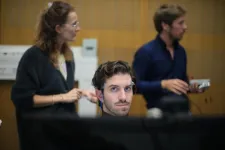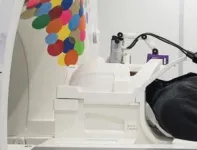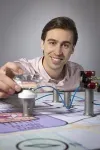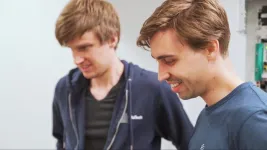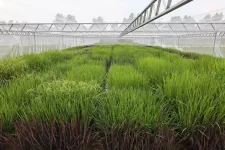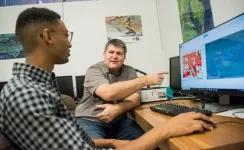Combining VR and non-invasive brain stimulation: a neurotechnology that boosts spatial memory without surgery
EPFL researchers have combined virtual reality, non-invasive brain stimulation and advanced brain imaging techniques to improve spatial navigation in healthy participants. The study is a first step in addressing dementia in an aging population without med
2024-10-30
(Press-News.org)
As we age, it becomes more difficult to remember where things are—whether it’s recalling where we left the keys or where we parked the car. This spatial memory deteriorates further with the onset of dementia, a condition that someone in the world develops every three seconds, according to Alzheimer’s Disease International.
Researchers at two EPFL labs have joined forces to give a boost to spatial memory by creating a unique experimental setup that combines non-invasive deep-brain stimulation, virtual reality training, and fMRI imaging—all housed within Campus Biotech in Geneva. Published in Science Advances, the study demonstrates that targeted, painless electric impusles to the hippocampus and adjacent structures, a deep brain region implied in memory and spatial navigation, can improve the brain’s ability to recall locations and navigate more effectively.
“By finding ways to improve spatial memory without surgery or medication, we are addressing a serious concern for a large and growing population: the elderly, as well as brain trauma patients and those affected by dementia,” says Friedhelm Hummel, head of the Hummel Lab.
The study is the result of a collaboration between the Hummel Lab and Olaf Blanke’s Laboratory of Cognitive Neuroscience (LCNO), both at EPFL’s Neuro X institute. By combining Hummel’s expertise in non-invasive brain stimulation with Blanke’s cognitive research of spatial navigation in virtual reality environments, the researchers developed a unique neuro-technological setup.
A one-of-a-kind combination of neuro-technologies
The experiment begins with researchers placing four harmless electrodes on the heads of healthy individuals to stimulate the hippocampus and adjacent structures. This non-invasive technique, called transcranial temporal interference electric stimulation (tTIS), sends targeted pulses without causing any discomfort for the participant.
Next, volunteers are immersed in a virtual world using VR goggles. Building on previous research by co-first-author Hyuk-June Moon, the scientists task the participants with navigating through a series of locations and remembering key landmarks. This immersive virtual setting allows researchers to precisely measure how well participants can recall and navigate spatial information whilst receiving tTIS.
“When stimulation was applied, we observed a clear improvement of the participants’ recall time—the time it took to start moving toward where they remembered the object to be,” says Elena Beanato, the other first author of the study. “This leads us to believe that by stimulating the hippocampus, we temporarily increased brain plasticity, which, when combined with training in a virtual environment, leads to better spatial navigation.”
The entire experiment was conducted within an fMRI scanner. This provided researchers with real-time images of brain activity, allowing them to monitor how the hippocampus and surrounding regions responded to tTIS during the spatial navigation tasks. The fMRI data revealed changes in neural activity associated with the observed behavioral changes, specifically in the regions responsible for memory and navigation, giving the researchers deeper insight into how non-invasive stimulation modulates brain function.
This integration of advanced technologies at EPFL's Neuro X Institute, makes Campus Biotech one of the few places where all three experimental techniques can be combined in a single study.
“The alliance of tTIS, virtual reality, and fMRI offers a highly controlled and innovative approach to studying the brain’s response to stimulation and its impact on cognitive functions,” adds Olaf Blanke. “In the long term, we envision using this approach to develop targeted therapies for patients suffering from cognitive impairments, offering a non-invasive way to enhance memory and spatial abilities.”
END
ELSE PRESS RELEASES FROM THIS DATE:
2024-10-30
An international research team led by QuTech has demonstrated a network connection between quantum processors over metropolitan distances. Their result marks a key advance from early research networks in the lab towards a future quantum internet. The team developed fully independently operating nodes and integrated these with deployed optical internet fibre, enabling a 25 km quantum link. The researchers published their findings in Science Advances.
The internet allows people to share information (bits) globally. A future quantum internet will enable sharing quantum information (qubits) over a new type of network. Such qubits ...
2024-10-30
Black patients are less likely than white patients to receive medical tests that doctors use to diagnose severe disease, such as sepsis, researchers at the University of Michigan have shown.
Because of the bias, some sick Black patients are assumed to be healthy in data used to train AI, and the resulting models likely underestimate illness in Black patients. But that doesn't mean the data is unusable—the same group developed a way to correct for this bias in data sets used to train AI.
These new insights are reported in a pair of studies: one published ...
2024-10-30
HOUSTON ― The University of Texas MD Anderson Cancer Center’s Research Highlights showcases the latest breakthroughs in cancer care, research and prevention. These advances are made possible through seamless collaboration between MD Anderson’s world-leading clinicians and scientists, bringing discoveries from the lab to the clinic and back.
Epigenetic targets and genomic stem cell pathways drive adult hair regeneration
Retrotransposons are interspersed repeating sequences that make up over 40% of the human genome. Proper tissue regeneration requires ...
2024-10-30
Toronto, ON, October 30, 2024 – Three Baycrest leaders are among those named winners of Women Executive Network’s (WXN) prestigious 2024 Canada’s Most Powerful Women: Top 100 Awards, celebrating exceptional leadership and groundbreaking achievements that have meaningfully transformed their industries, companies, communities and country.
Dr. Allison Sekuler, President and Chief Scientist, Baycrest Academy for Research and Education and President and Chief Scientist, Centre for Aging + Brain Health Innovation, powered by Baycrest (CABHI)
Dr. ...
2024-10-30
Cold damage is a major challenge in rice production, and identifying key gene modules in signaling pathways is a crucial means of addressing this issue. A Chinese research team has recently discovered a part of the plant’s cell membrane that helps plants sense when it's cold.
This cell membrane component, known as the COLD6-OSM1 module, triggers the production of a special molecule, 2',3'-cAMP, which helps plants sense and respond to low temperatures. This secondary messenger is a key upstream component that mediates the signaling pathway by directly responding to signals ...
2024-10-30
A new study in Nature finds that up to 215 million hectares of land (an area larger than Mexico) in humid tropical regions around the world has the potential to naturally regrow. That much forest could store 23.4 gigatons of carbon over 30 years and also have a significant impact on concerns like biodiversity loss and water quality. The study showed that more than half of the area with strong potential for regrowth was in five countries: Brazil, Mexico, Indonesia, China, and Colombia.
“Tree planting in degraded landscapes can be costly. By leveraging natural regeneration techniques, nations can meet their ...
2024-10-30
A heart attack can trigger a desire to get more sleep, allowing the heart to heal and reduce inflammation—and this happens because the heart sends special signals to the brain, according to a new Mount Sinai study. This research is the first to demonstrate how the heart and brain communicate with each other through the immune system to promote sleep and recovery after a major cardiovascular event.
The novel findings, published October 30 in Nature, emphasize the importance of increased sleep after a heart attack, and suggest that sufficient sleep should be a focus of post-heart-attack clinical management ...
2024-10-30
A new analysis led by researchers at Washington University School of Medicine in St. Louis has revealed detailed 3D maps of the internal structures of multiple tumor types. These cancer atlases reveal how different tumor cells — and the cells of a tumor’s surrounding environment — are organized, in 3D, and how that organization changes when a tumor spreads to other organs.
The detailed findings offer scientists valuable blueprints of tumors that could lead to new approaches to therapy and spark a new era in the field of cancer biology, according to the researchers.
The study is part of a group of 12 papers published Oct. 30 in the Nature suite of journals by members ...
2024-10-30
The wider Caucasus region, between the Black and the Caspian Seas, connects Europe, the Near East and Asia. It displays a huge geographic, ecological, economic, cultural, and linguistic range today, from the steppe zone in the north, the Caucasus mountains in the center, to the highlands of today’s Armenia, Georgia, Azerbaijan and Iran in the south. This diversity was no different in the past, where the archaeological record attests to many different influences from many surrounding regions.
“It is precisely this interface of different eco-geographic features ...
2024-10-30
Cancers are diseases of abnormal cellular growth, and although many are treatable or even curable, their origins are not necessarily clear. Understanding the precise timing of cellular events—as cells transition from normal to cancerous conditions—is key to uncovering new treatments or diagnostic opportunities.
Scientists from Vanderbilt University, led by Mirazul Islam, a graduate student mentored by Professor of Cell and Developmental Biology Ken Lau and Professor of Medicine Robert Coffey, have laid the groundwork for understanding and predicting the natural transition between precancers and cancer. They showed that colorectal cancer is likely to ...
LAST 30 PRESS RELEASES:
[Press-News.org] Combining VR and non-invasive brain stimulation: a neurotechnology that boosts spatial memory without surgery
EPFL researchers have combined virtual reality, non-invasive brain stimulation and advanced brain imaging techniques to improve spatial navigation in healthy participants. The study is a first step in addressing dementia in an aging population without med
